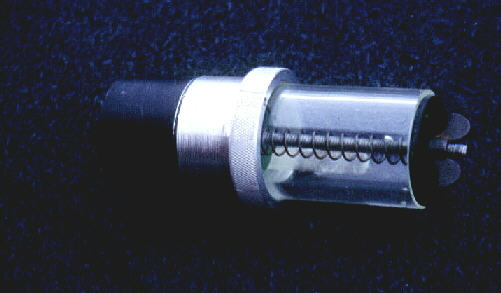Cooled Camera
CO2

In this view, the camera is laying on its side with the front to the left and the back to the right. A solid Plexiglas plug, about one-inch in thickness, forms the front of the camera and is held to the aluminum body of the camera by springs internal to the Plexiglas and aluminum. One piece of film would be loaded, in total darkness, between the Plexiglas plug and the aluminum camera body. To the right of the aluminum camera body is a Plexiglas cylinder which has a threaded central rod that acts as a guide for a spring that holds a piston against the opposite side of the aluminum camera body. If solid carbon dioxide (dry ice) is put in this cylinder, it will cool the aluminum, and consequently the film. The cooled film can be exposed in this cooled state until frost forms over the front surface of the Plexiglas plug. Film is cooled to very low temperatures to avoid reciprocity failure (reducing film sensitivity) which occurs under conditions of long exposures at low light levels. Because the camera has to be rewarmed before another piece of film can be loaded into it, at least two such cameras have to be used for a night of observing. There is no shutter in such a camera; the telescope is covered and uncovered to begin and end the exposure. I dimensioned my six-inch f/4.0 telescope for use with these two cameras, and made the dimensions of the cameras the same as a long-focal length Erfel eyepiece, so the telescope could be used both optically and photographically.